
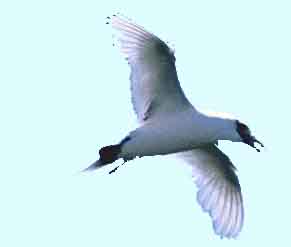
Copyright © May 2003
Table of Contents
- What You Ought To Know About
How To Fly At A Low Fare
- Ireland's Emerald Package
- Czech Out Czech Castles
- Fly Me Away Over Italy
In My Beautiful Balloon
- Multicultural Differences in Greetings You Need to Be Aware Of—
by Susan Dunn
- You Deserve To Visit A Fantastic Caribbean Paradise!
- Your Palau Dive Adventures
|
Welcome! to Psssss.....t!—Your Flight To Quality
webZine—Your One-Stop Information Center. Here is everything you need!—"Click" on most
resources mentioned in the following articles...
What You Ought To Know About
How To Fly At A Low Fare
by
Marilyn King
Copyright © Marilyn King 2003
 Would You Like To Fly At A Low Fare? You can fly at a low fare with
consolidator tickets. Consolidator tickets are available on major airlines. They are
generally sold for international travel. Flying with consolidator tickets is the same as
flying with published fare tickets. You fly on a major airline—but you really save money. Lower
priced tickets are available because consolidators buy a certain dollar volume of tickets from the
airlines. The airlines give them low, contract rates. These savings are passed on to you—the flying
customer.
Would You Like To Fly At A Low Fare? You can fly at a low fare with
consolidator tickets. Consolidator tickets are available on major airlines. They are
generally sold for international travel. Flying with consolidator tickets is the same as
flying with published fare tickets. You fly on a major airline—but you really save money. Lower
priced tickets are available because consolidators buy a certain dollar volume of tickets from the
airlines. The airlines give them low, contract rates. These savings are passed on to you—the flying
customer.
Can you can get a cheaper ticket if you wait until the last minute—when "airlines sell off
blocks of unsold seats to consolidators, who then re-sell for whatever they can get"? No—it
doesn't really work that way. Sometimes you can get a cheap ticket on very short notice. But
the best way to be assured a cheaper ticket is—plan ahead. It may be impossible to get a
reasonable price or even find a seat at the last minute.
Airlines know for any given flight a certain percentage of seats will be empty. By "selling"
these seats to consolidators, airlines increase the odds of flights being full. Once a plane leaves
the gate with empty seats, it is lost revenue for the airline. Consolidators bear the burden and
expense of marketing these "cheap seats." This is why airlines can afford to sell these
seats to consolidators at deep discounts.
Buy a consolidator ticket—you save between 10%–70%...or more... off the airlines' published
fares. During airfare sales, you might get a cheaper ticket with a published fare. But that
is not the normal case—particularly during spring and summer season.
There are a few differences between published fare tickets and consolidator tickets—






 Consider the differences between a consolidator ticket and a published fare ticket. Make sure to
find out the rules before you buy your ticket. Enjoy your savings the next time you fly. You
deserve to fly at a low fare!
Consider the differences between a consolidator ticket and a published fare ticket. Make sure to
find out the rules before you buy your ticket. Enjoy your savings the next time you fly. You
deserve to fly at a low fare!
 International Air Fares!—"ONLY" originating from U.S.—20%–55% off
Published! Deep discounts to many worldwide destinations...when originating from the US
International Air Fares!—"ONLY" originating from U.S.—20%–55% off
Published! Deep discounts to many worldwide destinations...when originating from the US
Click our logo—
Ireland's Emerald Package
Air, Car & 6 Nights
From $399
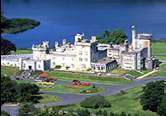 A glance out of the window of your plane as you approach Ireland—is all that's required to learn
why this ancient land is known as the Emerald Isle. Forty shades or more of green sewn together
in a patchwork quilt of lush countryside. A rich, rolling, vibrant land combining youthful vigor
and a long tumultuous history into an alluring combination. Cliffs and craggy coastline—quaint
villages and castles—crystal lakes and rolling glens. Ireland has much to offer you!!
A glance out of the window of your plane as you approach Ireland—is all that's required to learn
why this ancient land is known as the Emerald Isle. Forty shades or more of green sewn together
in a patchwork quilt of lush countryside. A rich, rolling, vibrant land combining youthful vigor
and a long tumultuous history into an alluring combination. Cliffs and craggy coastline—quaint
villages and castles—crystal lakes and rolling glens. Ireland has much to offer you!!
Ireland's famous "Emerald Package" is back due to popular demand and for a limited time—$399.
Take advantage of this reduced price for travel next fall by booking before July 15, 2003. Don't
miss out on this great price! Package Includes:
- Round Trip Airfare To Ireland
- 6 Nights Accommodations—1st Night Hotel & 5 Night Farmhouse B&Bs
- Weekly Car Rental including unlimited mileage, VAT, 24 hour roadside assistance—12 hour
grace period on return day***
- Full Irish Breakfast each morning
- Complimentary "Irish Coffee Welcome Orientation" on 1st evening
- Sales tax, VAT, & Services in Ireland
***U.S. Travelers can take advantage of Hundreds of Saving Opportunities***
Optional Upgrades:
- Collision Damage Waiver (SUPER CDW!) is only $85 total per week
- Upgrade to Emerald Castle Package from only $100 pp extra!!—spend your final
night in one of these 5-star luxury castles: Dromoland, Adare, Ashford, Waterford Castle)
- Upgrade to Private Bath and additional 1,700 Town & Country B&B's $36 per
person total
- Upgrade to Automatic Car $36 per person total for the week
Nov 1–Dec 16, 2003: **$399** JFK, BOS, BWI, DCA
**$489** ORD **$599** LAX
May 1–Oct 31, 2003—Great Rates Also Available! Please Ask!
Don't Delay—
Must Book by July 15, 2003
Please note: Package is based on 2 people traveling, double occupancy
accommodations and midweek travel. It is an Instant Purchase, Non-Changeable, Non-Refundable
& Subject to availability. Departure taxes are not included.
|
Czech Out Czech Castles
History! Magic! Romance! Architecture!
by
Marilyn King
Copyright © Marilyn King 2003
Yes, of course Prague is wonderful, and you should spend at least a week there. I recently lived
there for eight months.
But if you really want to get to know the Czech Republic—explore the beautiful countryside. Visit
a few of the hundreds of castles. The Czech Republic is a castle lovers dream!
Over 2000 castles, chateaus, and castle ruins have been preserved and are currently found in the
Czech Republic—including the largest castle complex in the whole world, Hradcany—the Prague
Castle!
Why? Czech Republic is in the heart of Europe—a major crossroads of trade routes, and cultural
influences. Starting with ancient Slav settlements (about 1000 AD) to the golden age of castle
building in the 13th and 14th centuries.
Forty years of communism kept most of this a secret. Today these treasures are being proudly
restored and updated. Discover some of the wonderful castles of the Czech Republic countryside
with me—
Prague—Fresh air! Vacationers and locals cruise on
the Vltava,
drink and dine outside near Charles Bridge, and...
visit Hradcany Castle in the distance.
Photo by Abel O'Kian
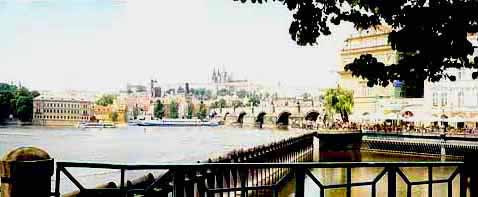
Most famous is Prazsky Hrad (Prague Castle)...okay, it's not in the countryside, but you
can't do Czech castles and skip this one. Allow at least half a day (it does not include time for
museum visits) if you want to examine it in depth.
Prague Castle is the most popular sight visited in Prague—and the largest ancient castle in the
world. Begun around 880, it has a very long history. Built on the site of an old Slavic settlement
on a hill, it overlooks the Vltava River. A wooden fortress already stood on the hill by 870 AD.
Slowly it got larger and larger, built of wood, but parts being replaced by stone buildings over
time. (Building in stone was much more expensive.) By 1135 most buildings were made of stone,
and the Czech Kings made the castle their main residence.
The castle reached it's zenith of importance during the reign of Czech king Charles IV. He had
very ambitious plans for it and his capitol city. Charles' son Vaclav had a new Royal palace built
in the old town in 1383, where the Kings resided after that date.
Rulers made their own additions so there is a mixture of styles. Prague Castle has had four major
reconstructions, but it retains its classical facelift from the 18th century—during the
reign of Maria Theresa of Austria. She painted all the buildings yellow which was her favorite
color—noblesse oblige—but they have since been restored. The castle has three courtyards
and has always been the seat of Czech rulers as well as the official residence.
Czech presidents have used Prague Castle as their principal office since 1918. When the
square presidential flag waves above the royal palace the President is in the country.
Konopiste Castle, about 55 km east of Prague—was founded by noble family Benesovec
in the wooded valley of the river Sazava in 1300. A unique example of a French style castle in
Czech Republic, its rectangular ground plan was divided into a larger outer bailey in the west and
the inner castle in the eastern part. Seven round towers lined the periphery of the fortification
walls.
Architectural modifications took place through the centuries—until Konopiste was extensively
renovated into a residence for its last occupant, Archduke Ferdinand. (You remember him from
9th grade history?). To say that the Archduke was obsessed with weapons and
hunting trophies would be an understatement. In 1914, he was assassinated along with his Czech
wife Sophie Chotek in Sarajevo. This sad action started World War One.
Today, this beautiful romantic castle houses a fascinating valuable collection of historical weapons
and armor. Rich interiors contain Bohemian crystal chandeliers, hunting equipment and
unforgettable collections of hunting trophies—over 300,000 animals.
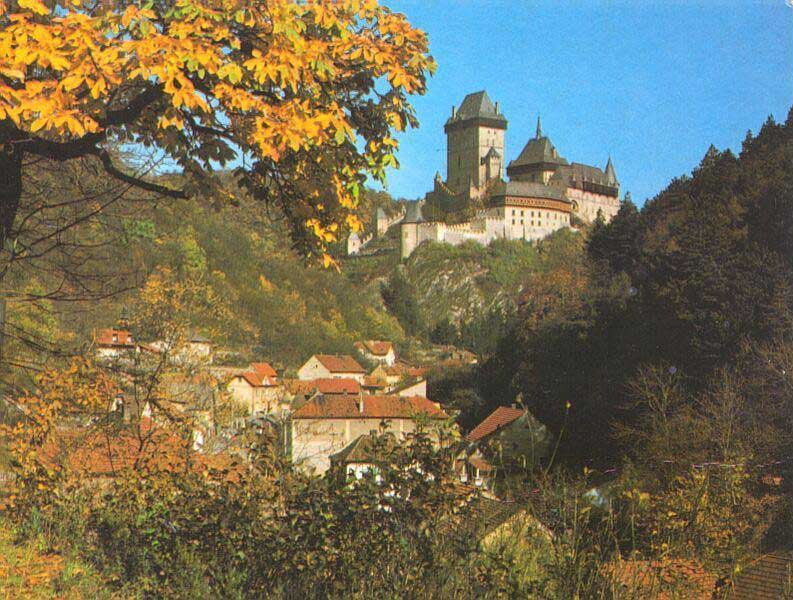 About 35 km southeast of Prague is Karlstejn Castle, founded by Czech King and Holy
Roman Emperor Charles IV in 1348. Built as a Royal Gothic castle, this massive complex served
as a vault for the Czech Coronation Jewels of the Holy Roman Empire and the Kingdom of
Bohemia.
About 35 km southeast of Prague is Karlstejn Castle, founded by Czech King and Holy
Roman Emperor Charles IV in 1348. Built as a Royal Gothic castle, this massive complex served
as a vault for the Czech Coronation Jewels of the Holy Roman Empire and the Kingdom of
Bohemia.
With many sieges and battles over the centuries, the castle slowly deteriorated. In the
18th century the Austrian Hapsburg rulers were aware of the historical significance
of Karlstejn and most seriously damaged parts were repaired. After 1853, work supervision was
taken over by a newly established Central Monuments Protection Commission residing in Vienna.
Karlstejn gained its present appearance with repairs made during 1887–1899. Its most precious
space is the "Chapel of the Cross". This spectacular room is decorated with semi-precious stones
embedded in the gilded stucco lower walls. Above this is the finest collection of Gothic painting in
the World—127 portrait paintings representing "the entire army of heaven" by Master Theodoric
from the 1360s. The ceiling is entirely gilded and adorned with real golden stars. Dividing the
room is a many-arched grate, hung with precious stones and jewels.
The only down-side is a steep uphill walk through a gauntlet of tacky tourist shops to reach the
castle—but it's well worth the effort. If you are not up to hiking uphill—take the horse drawn
carriage ride to the castle entrance.
About 35km north of Prague, near where the Elbe and Vltava rivers converge—sits Melnik
Castle and town of Czech queens. This early Gothic castle (1050–1100) was built upon an
old Slavonic fortified settlement (800 AD) . It became a Royal castle—was expanded twice
between 1400 and 1480, and rebuilt into a Renaissance chateau in 1553.
Princess Ludmilla was born in Melnik, and from her time forward, Melnik Castle has been the
residence of the queen widows of Bohemia. Under Emperor Charles IV, Melnik became a royal
city. His last wife had the castle's chapel with Gothic vaults built. The last queen residing in
Melnik, was the wife of Jiri Podebrad.
Different noble families occupied the Melnik Estate throughout the centuries until the castle was
abandoned during the Thirty Years War. In 1646 Count Czernin started a major reconstruction
with the early Baroque southern wing added. The Count purchased the Melnik Estate from the
Emperor. Heiress, Countess Ludmilla Czernin married Prince August Anton Lobkowicz in 1753.
With the exception of the Second World War and the 40 years of communist rule, Melnik Castle
remained in the family. The present owner Jiri Lobkowicz has been renovating the Castle since
1992.
Melnik Castle with its historic interiors houses the art collections, furnishings and hunting trophies
of the Lobkowic family. From the terrace overlooking the valley, you can see parts of the Royal
vineyards. The grapes that make the same kind of wine favored by the Czech Kings (500 years
ago) are still grown there. This special wine can be bought at the Castle gift shop in Melnik—as
well as some specialty wine shops in Prague.
I tasted wonderful Melnik wines in the romantic, mysterious cellar vault under the castle—dating
from the 14th century. A wonderful selection of both white and red wines presented
by candlelight—in this wine cellar which spans 1500m2 on three floors under the
castle. Next to an exhibition of old machines used for the vinification process—you find an
exhibition of fabulous heraldic animals that are found on coats of arms of different aristocratic
families. You walk over a fascinating floor created from thousands of wine bottles. Bottoms
up—remove any two and the whole floor would collapse!
Hluboka, the "Pearl of South Bohemia" is about 140 km south of Prague in South
Bohemia—above the Vltava near Ceske Budejovice. This famous place started as a Gothic castle
about 1250 to strengthen the power of the Czech Kings (the Premyslids). It remained a Royal
property and administrative center until 1562, and then turned into a stately Renaissance chateau.
In 1661 it was bought by the Schwarzenberg family—and 40 years later they had it rebuilt into a
Baroque styled chateau.
This lasted until 1841 when the charming chateau was rebuilt and modeled after Windsor Castle in
England. Romantic bays, balconies, barriers, battlements and other elements give Hluboka a
fairy-tale appearance. The chateau has magnificent and magical exteriors and interiors.
Surrounded by a vast chateau park with French and English gardens, riding hall and terraces—it
offers a view to the town and the river Vltava. One of the most visited chateaus in the Czech
republic, Hluboka is lavishly furnished with huge family collections of furniture, paintings, arms,
rare tapestries, and artifacts.
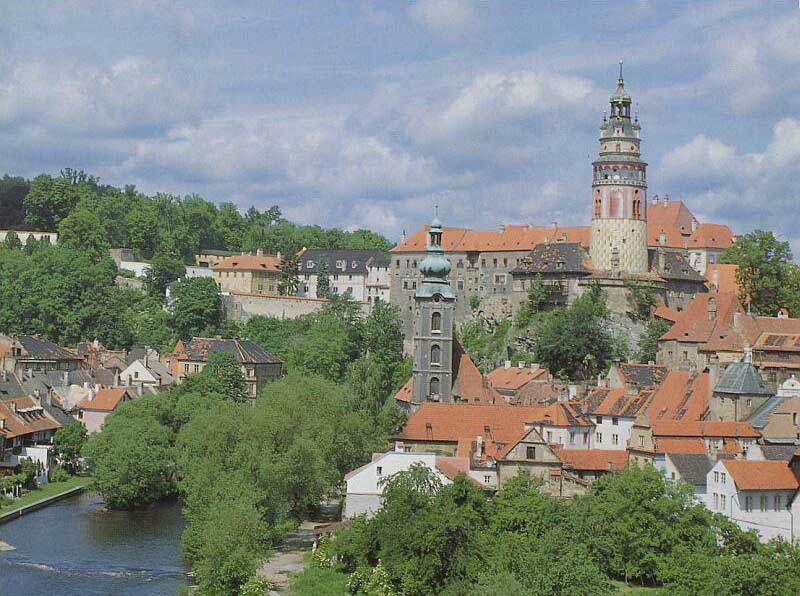 Cesky Krumlov is the 2nd largest Castle complex in Czech Republic.
Founded in 1230, the castle was expanded and remodeled several times. It had several owners
until 1947 when it was given to the Czech state.
Cesky Krumlov is the 2nd largest Castle complex in Czech Republic.
Founded in 1230, the castle was expanded and remodeled several times. It had several owners
until 1947 when it was given to the Czech state.
Its setting lording over the historic town is breathtaking. It has more than 40 buildings! It has
many valuable Renaissance and Baroque rooms, paintings, tapestries, and furnishings of the last
five centuries. It boasts the most unique 18th century Baroque theater in all of
Europe with all it's original furnishings and fixtures. The chateau garden with
Rococo summerhouse, fountain, small lake, chapel! Their rotary auditorium summer
theatre is one of ten most interesting theatres in the world.
Plus—all important Czech castles have live bears living in their non-water moats. Live
bears have been living in Cesky Krumlov Castle's moat since before 1600.
Pernstejn in South Moravia, this magnificent, well-preserved late Gothic fortress was
founded about 1250 as the seat of the Lords of Pernstejn. The castle's present appearance results
from its remodeling between 1450–1550. It became known as the "marble" castle because of the
marble-like local stone used to frame its doors and windows.
The castle preserved some of its Gothic vaulting. About 1600 the family was obliged to sell both
the castle and the estate—which marked the end of its days of glory. Around 1700, Baroque
alterations were carried out in some rooms, and in 1716 the ceilings of the chapel were decorated.
White stucco was added to the Knights Hall. The most authentic medieval castle in the Czech
Republic—it has no electricity or fancy interiors. Hidden in the forest, Pernstejn is one of the most
beautiful castles in Central Europe.
Helfstyn Castle in central Moravia is a ruin of a 16th century fortress.
Originally a rather small Gothic castle without towers, it was founded about 1310 by Knight
Fridus of Linava as a hideout. This Black Knight loved to rob people...and Czech King Jan
Lucembursky took the castle away from him.
Helfstyn Castle expanded substantially from about 1365 to 1385. About 1600, more extensions,
and in particular, mighty fortifications were made by Vilem of Pernstejn and his son Jan. The
effectiveness of the fortification system was apparent during the unsuccessful siege by the
Hungarians in 1468 and the Swedes during the Thirty Years War—(1618–1648). At the end of the
18th century Helfstyn was abandoned, but ever since the 19th
century—efforts have been made to preserve it.
The new Gothic Lednice and the Baroque Valtice in South Moravia—
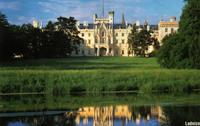 The romantic Lednice Castle is situated on the Austro–Moravian frontier near Breclav,
near an immense natural park. A Middle Ages stronghold, it was rebuilt as a Renaissance castle
in the 16th century. A garden was laid out next to it. Around year 1600 three ponds
were built, forming the basis for Lednice's landscape arrangement you see in present days.
The romantic Lednice Castle is situated on the Austro–Moravian frontier near Breclav,
near an immense natural park. A Middle Ages stronghold, it was rebuilt as a Renaissance castle
in the 16th century. A garden was laid out next to it. Around year 1600 three ponds
were built, forming the basis for Lednice's landscape arrangement you see in present days.
Today, Lednice is an excellent example of English Tudor neo-Gothic style and one of the most
important buildings of Romanticism at its peak. See prestigious rooms, an artificial stalactite
cavern, the rare tree of life made from ivory, a large landscaped English park with Minaret
Obelisk, and a French garden.
In 1715 the Lichtenstejns built a highway to connect their two castles—Lednice and Valtice.
The Valtice Castle, was not connected politically to the Czech lands—but had close
historical and family ties with Moravia and a similar cultural development. The oldest records
concerning Valtice date from 1192. In the 14th century the castle was
established.
The Lichtenstejn family became the owners of Valtice estate in 1395—and it was in their
possession until 1945. In the 17th–18th century the castle was rebuilt in
Baroque style. The ground plan has four wings, one courtyard, a tower and farming buildings.
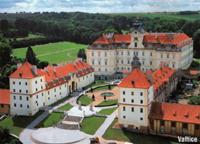 The interiors of Valtice Castle are decorated in 18th century styles—Baroque,
Rococo and Classical. All the rooms have lovely frescos, beautiful furniture (especially Rococo)
and valuable paintings.
The interiors of Valtice Castle are decorated in 18th century styles—Baroque,
Rococo and Classical. All the rooms have lovely frescos, beautiful furniture (especially Rococo)
and valuable paintings.
If you walk from Valtice Castle, you pass small Belvedere Castle and the Temple of Diana, also
called the Rendezvous. Walking towards Lednice through the forest you reach the romantic neo-
Gothic—Chapel of St. Hubert.
The castle list goes on and on. It's hard to make a bad choice. Czech out as many Castles as you
can.
Czech here...
Fly Me Away Over Italy In My Beautiful Balloon
Slip into the Rhythms and Atmosphere
of the Tuscan Middle Ages
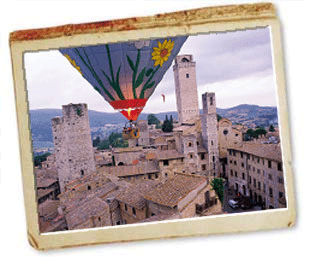 Buddy Bombard's Tuscany—An incredible experience in UNESCO World Heritage Cities
of Siena and San Gimignano!—Featuring Daily Sightseeing by Low–Level Balloon
Buddy Bombard's Tuscany—An incredible experience in UNESCO World Heritage Cities
of Siena and San Gimignano!—Featuring Daily Sightseeing by Low–Level Balloon
Italy!...Tuscany—The Medieval Splendor of Siena and its Palio, 7 Days, 6 nights
June 27–July 3 * July 1–7 * August 11–17 * August 15–21!
Tuscany is a richly landscaped region and wonderful to explore by balloon. The splendid rolling
landscape of luxuriant vegetation and constantly changing colors, textures, and patterns is
glorious. Terraced farms of wheat laced with vineyards and olive groves share the terrain with
cypress and pine, all bathed in beautiful Tuscan light. We will drift through towns perched on
hilltops, villages huddled within powerful protective walls and dominated by magnificent
cathedrals, Gothic abbeys, and mighty castles. Lovely and impressive country villas are
everywhere.
In addition to our daily low level balloon adventures in Tuscany we have arranged for
incomparable dining opportunities each day. We will dine as the guests of local Italian nobility,
and experience the finest authentic Tuscan cuisine prepared by private chefs and enjoyed with our
hosts in their historical castles and estates.
Each of our departures also includes Siena's highly charged and emotional 'Palio,' Europe's most
spectacular medieval festival dating back to the 13th Century. Organized by the
Sienese for their own pleasure and excitement, it is an authentic pageant from the city's distant
and colorful past. On July 2 and August 16 the whole of Siena converges on the city's magnificent
main square, the Piazza del Campo, for the procession, rituals and highly emotional horse race in
the square between the town's "Contrada," or neighborhoods.
Experience the spectacular Palio festival, pageant and horse race in
Siena's town square with premium seating provided by Buddy Bombard, who
weaves magical, 7 day Tuscan vacations surrounding this event including
his popular daily, low level balloon adventures through medieval Siena
and 13th Century San Gimignano, just-above-the rooftops of hilltop
towns, villas, mighty castles and gothic abbeys of Tuscany.
Also included are private sightseeing and rare, daily dining experiences with
Italian nobility (who are also Buddy Bombard's personal friends), in their historic castles and
estates.
Includes six nights accommodations at Park Hotel, Siena, all meals, fine wines with lunches and
dinners, balloon adventures, sightseeing, normal gratuities, round trip transfers from tour meeting
place, baggage handling.
For More Information and a...
|
Multicultural Differences in Greetings
You Need to Be Aware Of
by
Susan Dunn
Copyright © Susan Dunn 2003
Multiculturalism is a reality in the US and for those of us who do business globally. The US has
more legal immigrants yearly than all the other countries in the world combined. Also there are
vast cultural differences among "native" Americans living in the US for several generations, as
you know if you've done business with a New Yorker (better be quick!) or bi'ness with a Texan
(better stand at a 90% angle to your male companion).
Culture is not ethnic or racial. It is learned and of course each culture is different. Treat everyone
like a unique individual, as you would like to be treated, don't get hung up on stereotypes, and
develop your emotional intelligence so you can be more intuitive about how to communicate with,
negotiate with, and provide services and products for people from cultural backgrounds other
than your own.
- 1. In South Texas, if you're talking to a male, they will stand at a 90% angle to you.
If you move to reorient, a "dance" will begin. This is a markedly non-intimate position (macho),
and often the eyes are cast down at the floor or out across the floor, not at the other party. South
Texans generally say "Pleased to know you," while Mid Westerners say, "Pleased to meet you" or
"Pleased to make your acquaintance." More from San Antonio, Texas - in a strictly social setting,
it's not customary to shake hands with women. In society, there's the haute hug - two women will
parody a hug with no part of their body touching, just tapping each other on the back. Often with
an older, respected person, or to express affection with respect, you shake hands, then cover their
and your hands with your left hand, patting or stroking while maintaining eye contact.
- 2. Be aware that most of the world does not greet by shaking hands.
- 3. People from Asian cultures bow in greeting, but the bows are different.
People from Cambodia and Laos will often bow with both hands together in front of the chest as
if praying. In Japan, the depth of the bow signifies the level of respect for the other party. Many
Koreans prefer bowing and if they shake hands, the right hand is supported at the wrist by the left
hand to show respect. Thais bow with palms together about chest-high with their fingers
outstretched. And, there are exceptions. The Taiwanese usually nod the head in recognition rather
than bow.
- 4. Some cultures naturally greet by hugging.
Native Hawaiians hug each other, exchanging breaths. The custom is called "aha". Ancient
Hawaiians, incidentally, actually bumped heads together. Mexicans use the abrazo.
- 5. Some cultures kiss!
If your Cuban male client kisses you on the cheek, you know you've made the short list.
Immigrant men from the Middle East often shake hands with a slight nod or bow and then
exchange kisses on both cheeks. Men from that country usually don't shake hands with women,
nor do they introduce the woman with them. Do not attempt to shake hands with a Middle
Eastern woman unless—and here's where the EQ comes in—she extends her hand. Men in Eastern
Europe, Portugal, Spain and Italy will often kiss male friends on the cheek.
- 6. Pakistanis (largely Muslims) greet with salaam which is the equivalent of our "hello".
The salaam is done by bowing with the palm of the right hand on the forehead. Salaam means
"peace" or "Peace be with you."
- 7. Postures also have meaning.
Ready to settle in with your Middle Eastern client? As an American, you're likely most
comfortable sitting back in your chair and crossing your legs. Well, don't! In the Middle East, one
of the most insulting things you can do is sit with your legs crossed so the bottom of your foot is
pointed in the other person's direction. The foot is the dirtiest part of the body and the sole of the
shoe is the dirtiest of the low. To show someone the bottom of your foot means you're looking
for a fight!
- 8. Even hand-shaking cultures such as England, France, Germany, Italy and the US do it
differently.
Brits prefer a brief but firm handshake. The French prefer a light grip while sharing one gentle
single shake that is quickly withdrawn. Germans will give a very firm handshake—just one "pump"
then quick withdrawal. More than one shake with Germans or French is considered aggressive.
Italians will shake hands and then hug friends or kiss them on both cheeks. In many southern US
states, it is not customary to shake hands with women.
- 9. Bear in mind the other person may be trying to accommodate to your culture, so don't
assume they will use their traditional greeting.
For example, if you start first, for instance bowing, and then see a hand extended for a shake, and
switch to that, the other person will then have switched to a bow and this becomes awkward. For
many cultures such "awkwardness" will kill the deal early on.
- 10. Greetings are critical first moves in relationships.
Begin with a polite word or two, such as "Mr. and Mrs. Taekwondo, it's so nice to meet you at
last," and then hesitate for a moment to see what they want to do and are comfortable with. Then
mirror their gesture, be it bow, hand shake, abrazo (hug) or nothing! Use your intuition! When in
doubt, err on the side of conservatism.
(c)Susan Dunn, The EQ Coach,
http://www.susandunn.cc .
Individual and executive
coaching in emotional intelligence. EQ culture
programs for organizations. Distance learning.
EQ Alive!- http://www.eqcoach.net -
train to coach
emotional intelligence, classes start monthly.
Mail to Susan Dunn:
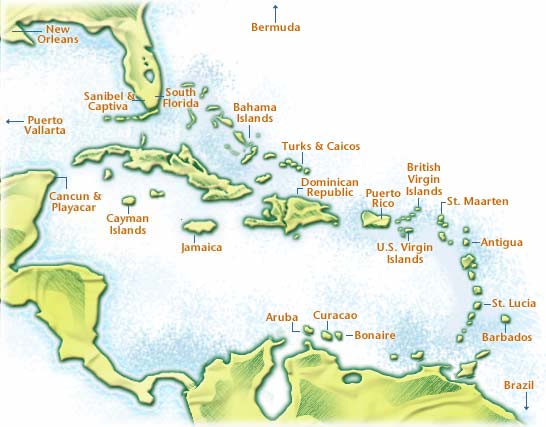
You Deserve To Visit A Fantastic Caribbean
Paradise!
Visions of paradise reflecting on beautiful stretches of powder-white beaches and incredibly clear
azure waters.
Romance, fun and excitement! Adventurous water sports and outdoor activities! Shopping,
dining and nightlife! Islands of unusual landscapes, friendly residents, balmy breezes and tropical
rhythms—
Rock bottom specials! Thrilling destinations! Standard to Deluxe accommodations! All-Inclusive
resorts! Air-Inclusive packages! Negotiated special prices!
Our "Rock Bottom" specials are guaranteed to be the lowest rates you can find. We guarantee
they are the lowest resort land price and will match any other rate we can verify with the
resorts.
Find your paradise on a Caribbean island—safe, familiar, and close to home. Escape to white sands,
turquoise waters, and tropical climate.
 Reward Yourself with a Fantastic Caribbean Paradise—Save Now!
Reward Yourself with a Fantastic Caribbean Paradise—Save Now!
Your Personal Booking Engine is provided by Flight To Quality—
"Your One-Stop Worldwide Travel and Information Center."
Click the map logo—
Stay current with Your One-Stop Information Center!—Your Air! Your Hotel! Your Car!
Your Cruise! Your Complete Travel! Above! Over! Through!...and...Under!—
Subscribe to "Psssss.....t! Your Flight To Quality webZine"—Psssss.....t!
Subscribe Me Now
and receive your FREE eGift
|
Find My Lowest Air Fare on
FareBeater®!

Soft Scuba
"The Soft Scuba Adventurer"
 We are back! We have refocused our scuba operations. We offer you even better service.
Your diving and accommodations cost you about the same—whether you use our services or
our competitors'. We simply give you better service. We want your repeat business to other
dive adventure destinations. When we work together, you receive customized service. We
"mother hen" a little. You deserve your best-possible underwater adventure. We want you
back with us again...and again.
We are back! We have refocused our scuba operations. We offer you even better service.
Your diving and accommodations cost you about the same—whether you use our services or
our competitors'. We simply give you better service. We want your repeat business to other
dive adventure destinations. When we work together, you receive customized service. We
"mother hen" a little. You deserve your best-possible underwater adventure. We want you
back with us again...and again.
All dive and accommodations cost about the same. Let's talk about airfare. Airfare can vary
considerably. Many times, if you reserve with sufficient lead time, we can get the lowest fares
through bulk air contracts. We always compare our bulk fares with what our wholesalers
offer. Oftentimes, wholesale fares are lower than bulk air! We also make use of the leading
Internet technology available. Our FareBeater® Engine sometimes beats our
wholesalers! For your FREE consumer report about
how much FareBeater® fares are lower than those offered by
Orbitz®, Expedia® and Travelocity®
visit—
FareBeater® Engine beats
Travelocity®, Orbitz®, and Expedia® by up to $341 per ticket!
[Yes, you may use it!—test fly it and
compare!]

Dive Micronesia!
Truk Lagoon, Palau, Yap, Guam,
Kosrae, Saipan, Tinian, Rota, Pohnpei, Ulithi, and
Bikini
Micronesia comprises a vast
area in the South Pacific. Truk (Chuuk) Lagoon, Palau and Yap are very popular dive
adventure destinations. Discover new Micronesian dive adventure destinations—Bikini, Guam,
Kosrae, Pohnpei, Saipan, Tinian & Rota, and Ulithi. Many WWII Pacific Campaign battles
were fought throughout Micronesia. Well-preserved wrecks are "artificial" reefs over half a
century young. Overgrown with great variety of sealife! World-class diving!
Diving—You travel
from around the world. Experience Micronesia's most valuable treasure...it's coral reefs and
spectacular wrecks. Visibility often exceeds 100 feet. You have a choice of islands. Enjoy drift
diving, shallow and deep wreck diving and greater variety of colorful sea life. Marine
biologists have discovered more species in Micronesia than in any other part of the
planet.
Entry—You need a
Passport—and a return or ongoing airline ticket.
Weather & Water—Enjoy your best
conditions from January through May—which is low season
as far as prices are concerned. Water temperature remains ~84 deg.F. year round. Visibility is
usually over 100 feet.

Your Palau Dive
Adventures
Palau—an incredible cluster of islands and giant lagoon.
The diverse diving cannot be matched anywhere else. Inside the lagoon the glistening flat
ocean surface is sprinkled with 328 rock islands. These unusual formations are topped with a
thick green growth of tropical foliage. Small marine organisms have spent centuries boring
into their limestone base, sculpting them into fantasy mushrooms. Clustered together, the
rock islands form lovely and intricate passageways through which boats motor at full
speed.
Palau is world renowned for spectacular drop-offs. Vertical walls begin at a depth of two feet
and plummet straight down to more than 1,000 feet. Diving these magnificent formations is
an exhilarating experience. More than 50 shipwrecks are sunk in the lagoon—remnants of
WWII attacks. Most ships are Japanese, but sunken aircraft are both American and
Japanese.
A landlocked marine lake offers a bizarre opportunity to dive with a million non-stinging
jellyfish. Blue holes, giant undersea tunnels, stalactite filled caves and a dozen more oddities
make Palau Lagoon different from any other place in the world.
 Fabulous Wall Diving—Palau is best known for its
spectacular wall diving. Vertical drop-offs provide the opportunity to enjoy 200–foot
visibility and a spectacular array of colorful marine life. Some of the deep gorgonian fans
reach gargantuan proportions—15 feet tall and 10 feet wide!
Fabulous Wall Diving—Palau is best known for its
spectacular wall diving. Vertical drop-offs provide the opportunity to enjoy 200–foot
visibility and a spectacular array of colorful marine life. Some of the deep gorgonian fans
reach gargantuan proportions—15 feet tall and 10 feet wide!
Ngemelis Drop-Off—On the north
side of German Channel, the reef begins in two feet and plummets vertically to more than
1,000 feet. It is world renowned for its giant gorgonian fans and magnificent soft corals in
radiant yellows, purples, oranges and golds.
Blue Corner—One of Palau's most
exciting sites, the wall makes a 90 degree turn, forming a sharp point that juts out into the
open sea. Divers drift, letting the current carry them around the point. This is a high voltage
dive. Divers encounter packs of Gray Reef Sharks swimming in the current, moving very
close to the wall. This spot is famous for Blue Marlin, Manta Rays, Dogtooth Tuna and
schools of over 100 Pacific Barracuda and other pelagics.
Siaes Tunnel—Siaes Tunnel is another
extraordinary dive that can be experienced only in Palau. On the west side of the atoll the
vertical wall line juts out into the Philippine Sea, forming a very pointed corner, where a
horizontal tunnel cuts right through the wall. This huge tunnel measures some 50 feet high.
The ceiling is approximately 80 to 90 feet, while the floor is at 120 to 130 feet. The interior is
covered with soft corals and deepsea gorgonian fans. Halfway through the tunnel there is a
"window" in the wall that looks out into the deep blue sea.
 Big Drop-Off—In a protected area
close to Ngemilis Island this wall dive begins in five feet. Absolutely vertical, it offers a
multitude of large fans and rare tropicals.
Big Drop-Off—In a protected area
close to Ngemilis Island this wall dive begins in five feet. Absolutely vertical, it offers a
multitude of large fans and rare tropicals.
New Drop-Off—Halfway between
Blue Corner and Big Drop-off, this vertical wall is similar to Blue Corner where a horizontal
shelf sticks out of both ends. The spot is a favorite for Gray Reef Sharks, Dogtooth Tuna,
Manta Rays and Blue Marlin.
Shark City—A vertical wall, it forms a
point jutting out into the open sea. A deep-V crevice cuts into the vertical face of the wall.
Several giant Table Corals measuring six to eight feet in diameter are found It is a favorite
haunt for several Gray Reef Sharks and a school of Barracuda.
Jellyfish Lake—This is one of the
strangest bodies of water known. Millions of years ago, a geologic upheaval caused a portion
of Palau's lagoon to become trapped in a landlocked lake in the center of a larger rock island.
To reach this lake, divers hike over a steep ridge and descend into a valley surrounded by
jungle foliage. Although the lake is surrounded by high ridges on all sides, it is fed seawater
through a maze of cracks and fissures in its limestone base.
In this mysterious, prehistoric lake live million or more non-stinging jellyfish. Traveling in a
tightly clustered school, the cloud of jellyfish moves around the lake-following the sun's rays.
Instead of stinging and feeding upon stunned fish, these former predators have become
undersea farmers—growing their own food through photosynthesis. Divers can reach out and
touch these jellyfish without injury, even gathering them in their arms.
Chandelier Cave—Another fairyland
experience is a dazzling underground tunnel and cave system. Chandelier Cave is under and
inside the island of Ngarol. You enter this labyrinth through a 10–foot wide tunnel opening in
the side of the Rock Island. The top of the tunnel is approximately 15 feet below the
surface.
The cave system, comprised of five or six distinct chambers, meanders 400 feet or more
under the island with several chambers filled with magnificently colored flowstones and
crystalline stalactites. The freshwater portion is exceptionally clear as it forms a crystal lake.
You travel all that distance...you want to dive more than one island. We offer you many "specials"—depending upon when, where...and... how long.
Explore your options. Make some plans. Get back with us. We will customize your best deal—we
guarantee it! Fin over now—
Visit Palau and other Micronesian destinations in
pictures.
Subscribe and download your FREE eReport—
"How to Enhance Your Dive Adventures"
Soft Scuba—
Voice: (941) 331-2086
Fax: (208) 955-7705
Email us now:
We offer you more Dive Adventure Destinations.
Visit us now!— Soft Scuba
|
Stay current with Your One-Stop Information Center!—Your Air! Your Hotel! Your Car!
Your Cruise! Your Complete Travel! Above! Over! Through!...and...Under!—
Subscribe to "Psssss.....t! Your Flight To Quality webZine"—Psssss.....t!
Subscribe Me Now
and receive your FREE eGift
|
|

![]() Reward Yourself with a Fantastic Caribbean Paradise—Save Now!
Reward Yourself with a Fantastic Caribbean Paradise—Save Now!
 We are back! We have refocused our scuba operations. We offer you even better service.
Your diving and accommodations cost you about the same—whether you use our services or
our competitors'. We simply give you better service. We want your repeat business to other
dive adventure destinations. When we work together, you receive customized service. We
"mother hen" a little. You deserve your best-possible underwater adventure. We want you
back with us again...and again.
We are back! We have refocused our scuba operations. We offer you even better service.
Your diving and accommodations cost you about the same—whether you use our services or
our competitors'. We simply give you better service. We want your repeat business to other
dive adventure destinations. When we work together, you receive customized service. We
"mother hen" a little. You deserve your best-possible underwater adventure. We want you
back with us again...and again.

 Fabulous Wall Diving—Palau is best known for its
spectacular wall diving. Vertical drop-offs provide the opportunity to enjoy 200–foot
visibility and a spectacular array of colorful marine life. Some of the deep gorgonian fans
reach gargantuan proportions—15 feet tall and 10 feet wide!
Fabulous Wall Diving—Palau is best known for its
spectacular wall diving. Vertical drop-offs provide the opportunity to enjoy 200–foot
visibility and a spectacular array of colorful marine life. Some of the deep gorgonian fans
reach gargantuan proportions—15 feet tall and 10 feet wide! Big Drop-Off—In a protected area
close to Ngemilis Island this wall dive begins in five feet. Absolutely vertical, it offers a
multitude of large fans and rare tropicals.
Big Drop-Off—In a protected area
close to Ngemilis Island this wall dive begins in five feet. Absolutely vertical, it offers a
multitude of large fans and rare tropicals. A glance out of the window of your plane as you approach Ireland—is all that's required to learn
why this ancient land is known as the Emerald Isle. Forty shades or more of green sewn together
in a patchwork quilt of lush countryside. A rich, rolling, vibrant land combining youthful vigor
and a long tumultuous history into an alluring combination. Cliffs and craggy coastline—quaint
villages and castles—crystal lakes and rolling glens. Ireland has much to offer you!!
A glance out of the window of your plane as you approach Ireland—is all that's required to learn
why this ancient land is known as the Emerald Isle. Forty shades or more of green sewn together
in a patchwork quilt of lush countryside. A rich, rolling, vibrant land combining youthful vigor
and a long tumultuous history into an alluring combination. Cliffs and craggy coastline—quaint
villages and castles—crystal lakes and rolling glens. Ireland has much to offer you!!
 About 35 km southeast of Prague is Karlstejn Castle, founded by Czech King and Holy
Roman Emperor Charles IV in 1348. Built as a Royal Gothic castle, this massive complex served
as a vault for the Czech Coronation Jewels of the Holy Roman Empire and the Kingdom of
Bohemia.
About 35 km southeast of Prague is Karlstejn Castle, founded by Czech King and Holy
Roman Emperor Charles IV in 1348. Built as a Royal Gothic castle, this massive complex served
as a vault for the Czech Coronation Jewels of the Holy Roman Empire and the Kingdom of
Bohemia. Cesky Krumlov is the 2nd largest Castle complex in Czech Republic.
Founded in 1230, the castle was expanded and remodeled several times. It had several owners
until 1947 when it was given to the Czech state.
Cesky Krumlov is the 2nd largest Castle complex in Czech Republic.
Founded in 1230, the castle was expanded and remodeled several times. It had several owners
until 1947 when it was given to the Czech state. The romantic Lednice Castle is situated on the Austro–Moravian frontier near Breclav,
near an immense natural park. A Middle Ages stronghold, it was rebuilt as a Renaissance castle
in the 16th century. A garden was laid out next to it. Around year 1600 three ponds
were built, forming the basis for Lednice's landscape arrangement you see in present days.
The romantic Lednice Castle is situated on the Austro–Moravian frontier near Breclav,
near an immense natural park. A Middle Ages stronghold, it was rebuilt as a Renaissance castle
in the 16th century. A garden was laid out next to it. Around year 1600 three ponds
were built, forming the basis for Lednice's landscape arrangement you see in present days. The interiors of Valtice Castle are decorated in 18th century styles—Baroque,
Rococo and Classical. All the rooms have lovely frescos, beautiful furniture (especially Rococo)
and valuable paintings.
The interiors of Valtice Castle are decorated in 18th century styles—Baroque,
Rococo and Classical. All the rooms have lovely frescos, beautiful furniture (especially Rococo)
and valuable paintings. Buddy Bombard's Tuscany—An incredible experience in UNESCO World Heritage Cities
of Siena and San Gimignano!—Featuring Daily Sightseeing by Low–Level Balloon
Buddy Bombard's Tuscany—An incredible experience in UNESCO World Heritage Cities
of Siena and San Gimignano!—Featuring Daily Sightseeing by Low–Level Balloon